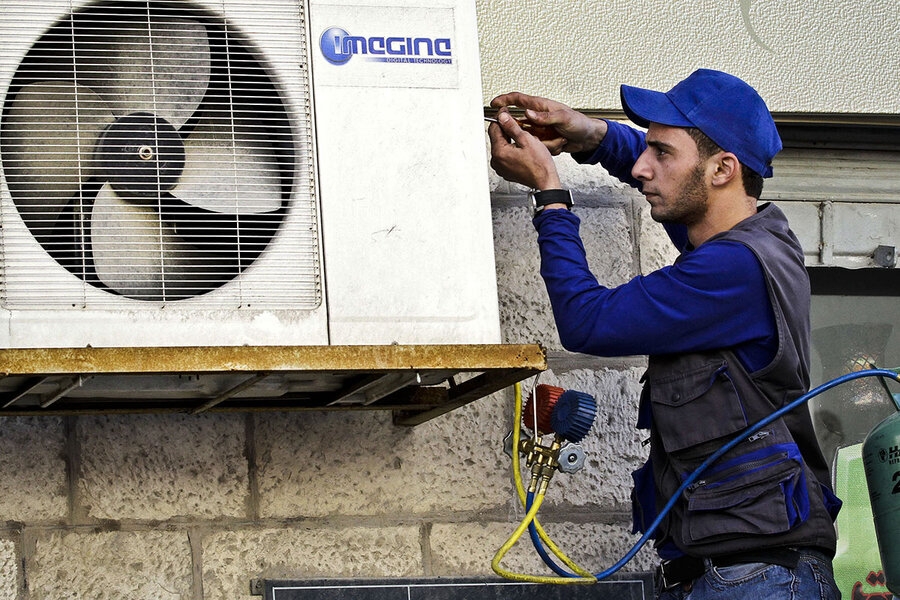In superheated Arab world, there are AC haves and have-nots
Loading...
| AMMAN, Jordan
Seeming desperate one morning, Khaled, an accountant, searches an electronics store in Amman that has been emptied of air conditioners, despite sticker prices of up to one month’s salary. “We have held out for years, but our children can’t study or sleep with the heat,” he says.
With temperature records being shattered around the Middle East, Arab societies are being divided into AC haves and have-nots. In August, Baghdad hit 125.2 degrees Fahrenheit. This month Jordan counted 13 days of 105 degree-plus temperatures, its longest recorded heatwave.
Why We Wrote This
Climate change has long been understood to have strong socioeconomic implications. With Arab world temperature records being shattered this late summer, access to cooling is being seen less as a luxury issue.
Builders in rapidly growing cities have discarded traditional construction methods that kept homes cool even in summer, and experts say the interiors of 75% of Jordanian homes are above the comfort range. “When you are inside the apartment or bedroom in Amman, it is as if you are out on the streets,” says Mohammed Taani of the Jordan Smart Cities Council.
But it’s not just the price of the AC units, it’s the cost of the electricity that keeps them out of reach for many. “I can’t afford [$170] a month for electricity to run an air conditioner,” says Yazeed Deifallah. “I am going to choose putting food on the table over comfort every time.”
For much of the Arab world, “hot” has taken on a whole new meaning this year.
In August, Baghdad shattered a record set in 2015 by hitting 125.2 degrees Fahrenheit, and followed up with multiple days over 120.
In September, it was the Levant’s turn at record-breaking heat, with Jordan counting 13 days of 105 degrees-plus temperatures, its longest heatwave in recorded history. Amman skirted 110 for multiple days, and the port city of Aqaba registered as the second-hottest place on Earth one day at 120. Eastern Syria hit 122.
Why We Wrote This
Climate change has long been understood to have strong socioeconomic implications. With Arab world temperature records being shattered this late summer, access to cooling is being seen less as a luxury issue.
Struggling to sleep, walk, or even think in Amman’s oppressive heat, Mohammed Al Farrag finds his only relief is walking into the neighborhood supermarket.
“I just want to cool down,” the Egyptian laborer says as he lifts his shirt by the freezer section.
As experts and the United Nations warn of climate change-induced heatwaves creating a “climate apartheid,” the dividing line between haves and have-nots in the Arab world can be summed up by just two letters: AC.
In the Levant, once home to dry, temperate summer days and cool nights, air conditioning has suddenly gone from an unnecessary luxury to a must have. Yet it is beyond the reach of many.
Seeming desperate late one recent morning, Khaled searches an electronics store in Amman that has been emptied of AC units, despite sticker prices ranging from 350 to 800 Jordanian dinars, or about $490 to $1,100, one month’s salary.
“We have held out for years, but our children can’t study or sleep with the heat,” the accountant says.
Warming pattern
In patterns that scientists say have been exacerbated by climate change, heatwaves in the Levant and North Africa are becoming more frequent, longer, and hotter, leaving millions struggling to keep cool.
“Much of the Middle East and North Africa have warmed since the industrial age,” says Zeke Hausfather, director of climate and energy at the Oakland-based Breakthrough Institute.
Jordan, Iraq, Saudi Arabia, and Syria have warmed about 3 degrees Fahrenheit since 1950, he says, noting that the region is projected to warm a further 1 to 8 degrees over the next 50 years, depending on global emissions.
“This long-term average warming makes it easier to have extreme temperatures outside the historic record become a regularly occurring event,” he says.
Even though a flood of Chinese and Turkish models has lowered the cost of AC units in the region in recent years, the price drop comes at a time that governments in Egypt, Jordan, Tunisia, and Saudi Arabia have lifted electricity subsidies and even imposed taxes on consumption, making the units several times more expensive to operate.
In other Arab states suffering chronic power outages or shortages – such as Iraq, Syria, and, increasingly, Lebanon – the dividing line has become not only who can afford an air conditioner, but the diesel-powered electric generators to run them.
In Jordan, an average family using an air conditioner can see their monthly electric bill jump from about $70 to $210.
Yazeed Deifallah, a father of two, is one of many Jordanians forced to choose between cooling and necessities.
“I can’t afford [$170] a month for electricity to run an air conditioner,” the father of two says as he drags an electric fan into his apartment on the seventh day of the heatwave.
“If I have to choose between staying cool or putting my daughter in a nursery so my wife and I can work, I am going to choose putting food on the table over comfort every time.”
The 1 percenters
The coronavirus has made this problem worse, too. Before the pandemic, on the hottest days, many working-class citizens in the Arab world would browse aimlessly with their families in air-conditioned malls.
Now closures, indoor capacity restrictions, reduced air-conditioning, and straight-up fear of infection is preventing or discouraging the practice.
Meanwhile, the coldest 1% have air-conditioned homes, remotely activate the AC in their cars before leaving their air-conditioned offices, and are able to manage home electricity bills that can spike above $2,000 a month.
“I know it is expensive, but you can’t put a price on comfort,” says Ali Majed, a Jordanian business owner whose electric bill in the summer is $1,400 a month and who pays a valet to cool his car for him.
And while residents of Iraq and the Levant struggle with the extreme heat, those in the fossil fuel-rich Gulf have taken air conditioning to unprecedented levels.
In preparation for the 2022 World Cup, Qatar is building an outdoor stadium that will pump cold air through outlets underneath each seat and on the sidelines for athletes. In the UAE and Qatar, cold air is pumped onto sidewalks and open air markets so that visitors can enjoy the outdoors despite 60% humidity and 110-degree heat.
New construction
Underlying the AC dividing line is an entrenched socioeconomic inequality that has transformed Arab capitals into megacities with miles of hastily constructed housing.
A lack of job opportunities fueled mass migration to cities; the population of Arab urban centers grew 400% between 1970 and 2010, and is expected to double to 400 million by 2050 – equivalent to the current population of the entire region.
Yet as the cities changed, so too did the way homes were built.
In order to meet the demand for affordable housing, engineers abandoned traditional construction techniques that kept buildings several degrees cooler even in the dog days of summer: with the use of local stone known for its natural insulation, and the placement of windows to maximize airflow.
In a bid to build on every possible inch, engineers ignored the centuries-old practice of positioning buildings to minimize direct sunlight during peak hours.
In their place rose towering apartment buildings made of concrete, cinder block, asphalt, drywall, and asbestos, with most rooms facing the sun at peak periods with porous insulation.
Experts say the interiors of 75% of Jordanian homes are above the comfort maximum of 75 degrees Fahrenheit indoors during the summer.
“I usually describe it like this: When you are inside the apartment or bedroom in Amman, it is as if you are out on the streets,” says Mohammed Taani, chairman of the Jordan Smart Cities Council and secretary general of the Arab Renewable Energy Society.
“New construction with improper insulation leads to 30% energy and heat loss. This means in extreme temperatures, Jordanians and residents in many Arab cities need AC close to 24/7 in the summer and heating 24/7 in the winter.”
Meanwhile, the mass of concrete and asphalt soaks up solar radiation by day and radiates heat in the evening, creating a “heat island” that offers little nighttime relief for residents.
Office on the street
On a drive through south Amman neighborhoods in August, men stripped down to undershirts and their children sat on balconies or leaned their heads out of windows, desperate for a breeze.
“Most people simply do not have the income for the constant air conditioning or heating needed in these unsustainable homes in extreme weather,” Mr. Taani says.
Another segment of AC have-nots in the Arab world is the 30% to 40% who work outside and in the informal sector – on farms, in workshops, on street corners, and in makeshift garages and tiny shops – and have poor or no access to cooling.
In cities such as Amman, Baghdad, and Damascus, street vendors wilt under the relentless sun.
Hossam sells boiled egg sandwiches from his stand, a prayer rug folded over his head for shade one humid morning.
“We don’t have office jobs for AC,” he says, dabbing his forehead with a wet cloth from his back pocket as he slathers a bun with hot sauce. “We only have one way to keep cool: Think about winter.”








